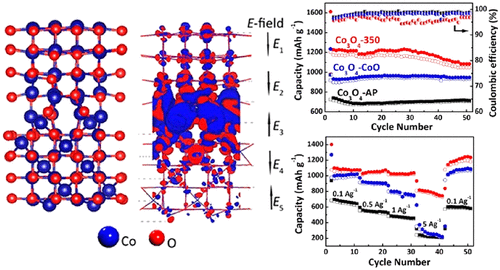当前位置:
X-MOL 学术
›
ACS Appl. Nano Mater.
›
论文详情
Our official English website, www.x-mol.net, welcomes your feedback! (Note: you will need to create a separate account there.)
Engineering Surface Structure and Defect Chemistry of Nanoscale Cubic Co3O4 Crystallites for Enhanced Lithium and Sodium Storage
ACS Applied Nano Materials ( IF 5.9 ) Pub Date : 2020-03-20 , DOI: 10.1021/acsanm.0c00614 Yanguo Liu 1, 2 , Haicheng Wan 1 , Hongzhi Zhang 1 , Jiayuan Chen 1 , Fang Fang 3 , Nan Jiang 1 , Wanxing Zhang 1 , Fangwang Zhou 4 , Hamidreza Arandiyan 5 , Yuan Wang 6 , Guanyu Liu 7 , Zhiyuan Wang 1, 2 , Shaohua Luo 1, 2 , Xiaobo Chen 4 , Hongyu Sun 1
ACS Applied Nano Materials ( IF 5.9 ) Pub Date : 2020-03-20 , DOI: 10.1021/acsanm.0c00614 Yanguo Liu 1, 2 , Haicheng Wan 1 , Hongzhi Zhang 1 , Jiayuan Chen 1 , Fang Fang 3 , Nan Jiang 1 , Wanxing Zhang 1 , Fangwang Zhou 4 , Hamidreza Arandiyan 5 , Yuan Wang 6 , Guanyu Liu 7 , Zhiyuan Wang 1, 2 , Shaohua Luo 1, 2 , Xiaobo Chen 4 , Hongyu Sun 1
Affiliation

|
Transition metal oxide nanostructures are drawing much attention as promising electrodes for advanced rechargeable batteries. However, due to the intrinsic low electronic conductivity and substantial volume change during cycling, the electrodes usually show low rate capability and poor cycling life. Herein, we report a route combining surface/interface engineering and defect chemistry to tune the lithium storage properties in nanoscale cubic Co3O4 crystallites. The Co3O4 crystallites were annealed in an inert atmosphere by carefully controlling the temperature, which induces the conformal formation of CoO layers with a tunable thickness on the surface of initial cubes. Microstructural characterizations and electrochemical measurements indicate that the optimized sample possesses a CoO thickness of ∼1.1 nm and shows a reversible lithium storage capacity of 1069.4 mAh·g–1 after 100 cycles of a current density of 0.1 A·g–1. A capacity of 807.9 mAh·g–1 can be obtained at a rate of 5 A·g–1. The improved lithium storage performance is attributed to the unique CoO–Co3O4 interface structure and defect chemistry, which induces a strong electric field at the sharp Co3O4–CoO interface according to density functional theory calculations. The optimized sample also shows it improved sodium storage properties. This work thus provides an effective strategy for the design and synthesis of advanced electrode materials for energy applications.
中文翻译:

纳米级Co 3 O 4纳米晶增强锂和钠存储的工程表面结构和缺陷化学
过渡金属氧化物纳米结构作为有前途的可充电电池电极备受关注。但是,由于固有的低电子电导率和循环过程中体积的实质变化,电极通常显示出低倍率能力和较差的循环寿命。本文中,我们报告了一种结合表面/界面工程和缺陷化学的途径,以调节纳米级立方Co 3 O 4晶体中的锂存储性能。钴3 O 4通过仔细控制温度,可在惰性气氛中对微晶进行退火,从而在初始立方体的表面上诱导形成厚度可调的CoO层。微观结构的表征和电化学测量表明,优化的样品具有的~1.1 nm的厚度的CoO和节目1069.4毫安的可逆锂存储容量·克-1 0.1 A·g的电流密度下的100次循环后-1。以5 A·g –1的速率可获得807.9 mAh·g –1的容量。锂储存性能的提高归因于独特的CoO–Co 3 O 4界面结构和缺陷化学,根据密度泛函理论计算,在尖锐的Co 3 O 4 -CoO界面处产生强电场。优化的样品还显示出改善的钠储存性能。因此,这项工作为能源应用中高级电极材料的设计和合成提供了有效的策略。
更新日期:2020-03-20
中文翻译:

纳米级Co 3 O 4纳米晶增强锂和钠存储的工程表面结构和缺陷化学
过渡金属氧化物纳米结构作为有前途的可充电电池电极备受关注。但是,由于固有的低电子电导率和循环过程中体积的实质变化,电极通常显示出低倍率能力和较差的循环寿命。本文中,我们报告了一种结合表面/界面工程和缺陷化学的途径,以调节纳米级立方Co 3 O 4晶体中的锂存储性能。钴3 O 4通过仔细控制温度,可在惰性气氛中对微晶进行退火,从而在初始立方体的表面上诱导形成厚度可调的CoO层。微观结构的表征和电化学测量表明,优化的样品具有的~1.1 nm的厚度的CoO和节目1069.4毫安的可逆锂存储容量·克-1 0.1 A·g的电流密度下的100次循环后-1。以5 A·g –1的速率可获得807.9 mAh·g –1的容量。锂储存性能的提高归因于独特的CoO–Co 3 O 4界面结构和缺陷化学,根据密度泛函理论计算,在尖锐的Co 3 O 4 -CoO界面处产生强电场。优化的样品还显示出改善的钠储存性能。因此,这项工作为能源应用中高级电极材料的设计和合成提供了有效的策略。



























 京公网安备 11010802027423号
京公网安备 11010802027423号